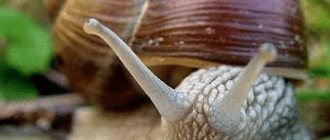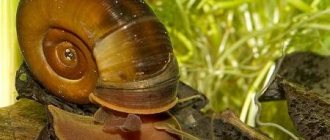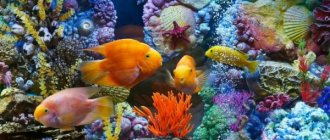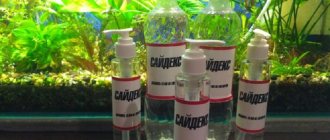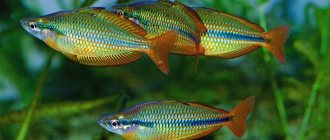09/28/2019Shellfish0
A home aquarium contains not only fish and snails. Among the underwater inhabitants of Perlovitsa is a bivalve mollusk. It also attracts the attention of fishermen as bait for burbot, crucian carp, and carp. The body of the mollusk is used in raw or boiled form. It was discovered and described at the end of the 18th century. Named from the English “pearl” - pearls.
- 1 Description and natural range, differences from toothless
- 2 Mr. Tail recommends: types of Perlowitz
- 3 The role of Perlowitz in natural and artificial reservoirs
- 4 Compatibility
- 5 Reproduction
Description and natural range, differences from toothless
Perlovitsa is a freshwater mollusk of the Unionidae family. It has an external resemblance to the toothless one, the first has a thin shell and is found in stagnant water, the second has teeth on the hinge ligament.
Shell structure: bivalve, thick, three-layered. The upper edge is slightly curved, the posterior edge is straight. The inner layer is like mother-of-pearl, white, blue. The height of the carapace is 23-40 mm, length – 72-90 mm, the shape is elongated, convex, smooth, shiny. The tops are wide and protruding. The color is yellow-green, brown, with longitudinal stripes, by which they recognize the age of Perlovitsa.
The shell has two openings, the first is wide, with many cilia. It is a supplier of food and oxygen. The other is narrow, called powder, excretory, to get rid of waste products.
The mollusk has a body with folds and a leg. On the dorsal part there is a growth where the internal organs are located. On the body there are cavities with fluid and with the heart and gonads.
The pearl barley is equipped with two muscles (locks), with the help of which the flaps are attracted to each other and slam shut tightly, protecting it from predators. They have no organs of vision or head, and their hearing is weak.
Photo gallery Perlowitz:
Breathing is through the gills; Perlowitz has two blades for this purpose on either side of the leg. In this case, water is sucked into the lower siphon, washes the gills and is thrown out through the upper (cloacal) siphon.
The shells move very slowly, they are more inclined to walk when the bright sun is shining. Speed – 1-1.5 m per hour. The rest of the time, individuals lead a sedentary lifestyle. Perlovitsa overwinter, burrowing into the silt in the fall, as if petrifying, keeping the shell valves tightly closed.
Habitat: freshwater rivers, lakes, ponds with sandy, muddy bottoms and slow currents. They live in the coastal or bottom parts of water bodies. They are found naturally in the Volga, Kama, Oka, and the Far East. They feed on plankton and detritus. Individuals are dioecious. Males release sperm into the water, which enter the female's mantle cavity, where fertilization occurs. They can live 15 years, but in an aquarium a maximum of 2 years.
Can they be eaten or cooked?
In European countries, the consumption of such delicacies as oysters and mussels, which are very similar in appearance to ordinary pearl barley, is widespread. Is it possible to eat river pearl barley caught in Russia and neighboring countries? Common pearl barley, caught in these countries, is quite edible. After all, pearl barley meat consists of protein - protein and it has long been used as feed for livestock and poultry. The main thing is to follow certain procedures when preparing shells because they are not eaten raw - this can be dangerous.
Toothless can contain larvae of worms - parasites that can survive in the human body for years, poisoning and depleting it.
It is important to cook toothless meat correctly. Preparing river pearl barley is not difficult. It is better to do this when you relax in the summer on the river bank. Take a saucepan or kettle, frying pan and knife with you.
A spoon can be made from half a seashell attached to a stick.
Also, grab: salt, onions, spices, garlic, herbs, vegetables and whatever will be on the side dish. It is worth noting that toothless can be pickled, but it will be better if it is subjected to heat treatment. The shell is first washed and then boiled in boiling water along with the shell. Then the shell is opened, the meat is removed and fried in a pan with spices and other ingredients.
Remember:
– you should not take half-opened river shells - they may already be dead.
– do not collect cucumbers in an ecologically unfavorable area - after all, they filter liquid, passing it through themselves and are capable of accumulating harmful substances.
Mr. Tail recommends: Perlovitz species
The most common types:
- Common (painters) - the largest, olive-yellow shell, 9-15 cm long and 4 cm high.
- Thick - rounded shell. Habitat: ponds with fast currents and clean water. It grows slowly.
- Wedge-shaped (swollen) - the shell is narrowed at one end, 9 cm long, 4 cm high, yellow or green. Grows faster than others.
- Far Eastern - the shell is distinguished by a red pearlescent hue, elongated. Dimensions: 8 cm long and 3.5 cm wide.
Fishing with pearl barley
The river shell is also useful for fishing enthusiasts. Fishing for pearl barley is going well.
Carp, crucian carp, rudd, catfish, burbot, bream, pike, roach and perch love river mollusks.
- In combination with the cockchafer and river cucumber, it also makes an excellent bait. The shell can be used in combination with maggots and worms.
- Before you go fishing, stock up on river cucumber, open the shell and simply place the pearl barley on the hook.
- It is worth noting that river shells are suitable for fishing even when fried or rotten.
- Fishing for river cucumber is considered successful only in those places where it lives.
Experienced fishermen recommend a dough recipe with pearl barley for bait. You will need fresh white pearl barley. It is steamed or boiled, supplemented with special activators. In addition to the contents of the shell you will need:
- A glass of cereal.
- Up to 6 glasses of water.
Pour into a saucepan and add liquid. No need to add salt. Salt is not typical for the river ecosystem. It will only scare away the catch. Cook in boiling water for up to one hour, stirring. Then put the pan in a warm place for 7 hours. Take it out and mix it with fresh river cucumber.
Reproduction
The breeding season for mollusks is April-May. The sperm of the male enters the reservoir, from there through the entrance siphon into the female, fertilizing her eggs. From several hundred to a thousand eggs appear. Embryos develop in the female's external gills.
When the larvae reach maturity (20-30 days after fertilization), they separate and float in the water. Then the glochidia, as they are called, attach to fish of the Cyprinidae family (gills, skin, fins). Thus, Perlowitz larvae parasitize until they reach maturity on perch, ruffe, roach, and silver bream.
Keeping in aquariums and open ponds
Perlovits can be bred for commercial purposes. For this purpose, special farms are organized in the form of open ponds, where pearl barley is kept in captivity.
To purify the water in an aquarium with fish, you can also add pearl barley. The shell gets along well with fish and feeds on their waste.
Lovers of a measured lifestyle will enjoy watching the unhurried movements of the shell. It is not recommended to place toothless ones in an aquarium. After all, the reproduction of shells directly depends on fish and other representatives of fauna, since they parasitize on their gills without causing significant harm. Certain conditions must be created for pearl barley in the aquarium:
– oxygen and sufficient bottom area;
– river or lake flora, for example, elodea or hornwort;
– aeration;
– lighting close to natural;
– the temperature regime of the aquarium’s aquatic environment should vary from 18 to 22 degrees;
– sand or silt – at least 50 mm.
It is not recommended to feed pearl barley at home. The container for keeping the toothless must have an ecosystem as close as possible to the natural one. Under such conditions, she will find food for herself.
Extraction of pearl barley
It’s not difficult to prepare plenty of pearl barley. The most promising place is a section of the river behind a sand spit. Such places with a slow current abound in all kinds of shellfish. To get the pearl barley, you need to run the net along the bottom several times. As a result, the landing net will be filled with shells.
Another traditional way of catching shellfish is to walk along the bottom and feel for them with your feet. By mid-summer, the shells burrow a little into the ground, but not completely, so there are no problems with groping.
Nutrition
Pearl barleys eat detritus (products of undecomposed organisms) and feed on plankton. The process of absorption of nutrients occurs through the ingestion of small particles that fall from the water onto the gills. These particles are enveloped in mucus and gradually move towards the mouth. The mollusk then swallows the food. And through the cloacal cavity, the mollusk removes processed food. The mollusk, which is about 8 cm long, can throw out its waste in a stream at a distance of up to 40 cm.
Age determination
The age of pearl barley can be determined in two ways.
The first is based on how many relief arcs encircle the shell valve, which are formed after wintering due to the suspension of the growth of the mollusk body. Only the relief stripes are counted, and it is easier to calculate how old a mollusk is by looking at the arched protrusions on the shell using the formula - the number of protrusions plus two.
Is it possible to make pearls?
It is unlikely that anyone will refuse a pearl thread. She is the dream of many fashionistas. However, not everyone knows how exactly such beauty arises in nature.
Pearls under natural conditions originate in the toothless fellows - pearl oysters. What is the difference between pearl mussel and pearl barley? In size and in years of life. The first one is larger and lives longer than the river shell.
Are there pearls in nature in pearl barley? Another difference and answer to the question is that pearl barley lives in harder water and under such conditions it is problematic to grow pearl barley.
Pearls in pearl barley must be grown artificially by planting a small foreign body. If you insert the implant into the shell correctly, then in 10–12 years you can get a pearl.
In addition, when a mote is introduced into a shell and its adaptation, a representative of the Unionidae family may die. The pearl in the body of the shell forms in layers, irritating the tissues of the river animal, and it reacts in response by secreting a protective pearlescent substance.
About bait and bait
Feeder fishing involves systematic feeding of the casting sector. When planning to use pearl barley meat as bait, it should be made an integral component of the nutritional mass. To do this, you need to crush a dozen or two shells, chop their contents and mix them with ordinary soil or dry factory bait without a strong odor - for example, winter bait (photo .
.
No attractants should be added. The second option is when the complementary food is mixed independently, and a portion of the cut insides of the shell is added to each feeder. Well, the third is the preparation of a nutritious mass from only crushed shells. Which one is better to adhere to is an individual question. I'm leaning towards the first option. It produces attractive turbidity and delivers the collected food to the fishing point in sufficient quantity. Great combination.
By the way, the mantles and gills of mollusks opened to prepare bait will not stay on the hooks, so if unnecessary, they can also be used as part of bait. And one more thing: in case of coarse grinding of shells, it is worth taking feeders that are more capacious.
It has been proven by experienced people that when fishing with pearl barley, hooking fish has a good effect. Alas, this method has also become rare today. True, not everywhere. Experienced fishermen with experience know a lot about this and therefore are not lazy to spend time on thorough preparation for fishing. They accustom fish to a certain type of food and its constant presence in specific places. Over the course of several days, shells are collected, crushed with stones, and then thrown into the water with “cobras,” “ladles,” and “spoons.” Less often they are dumped out of buckets and delivered to casting points on boats.
An interesting fact is that the natural habitat of living pearl barley is a kind of hint regarding the choice of a potentially promising river area for fishing. As noted above, the mollusk does not favor oxygen-depleted warm water. Therefore, near places where it accumulates, there are often underwater springs, streams flowing into the water, and river tributaries. In the hot season, fish also prefer similar conditions and stay there, while at the same time relying on shell rock as a potential food.
What color are the toothless and pearl barley shells?
1. diabetes mellitus is characterized by a lack of the hormone insulin, which is responsible for regulating the level of glucose in the blood, which is significantly increased in this disease.
2. As mentioned in the previous paragraph, insulin helps regulate blood glucose levels. With excess insulin, glucose levels become critically low. the patient should be given any sufficiently sweet product, ideally a couple of pieces of sugar, a few sweets or a piece of white bread.
3. The spinal cord is located in the spinal canal and consists of two halves, delimited in front by the median fissure and in the back by the median sulcus. the outside is covered with three shells - soft, arachnoid and hard (from deepest to superficial). Almost along its entire length, approximately in the middle, it has a central canal filled with cerebrospinal fluid. distinguish between gray (butterfly-shaped) and white matter of the spinal cord. gray matter consists of neuron bodies and partly dendrites, white matter - of axons. 31 pairs of spinal nerves, formed by the anterior and posterior roots, depart from the spinal cord.
4. The conductor function, roughly speaking, ensures the connection of all components of the body into a single whole; this will also include the vital connection between the spinal cord and the brain. The reflex function provides motor activity, as well as regulation of the functioning of internal organs, plus, of course, the implementation of unconditioned reflexes.
What types of bivalves are there?
Tridacna. Pearl mussels. Oysters. Scallops. Mussels
- Bivalve - marine and freshwater molluscs, which are characterized by the absence of a head, the presence of a wedge-shaped burrowing leg and the presence of a shell consisting of two valves. ...
- Giant tridacna (Tridacna gigas) is the largest species of bivalve molluscs (Fig.
Interesting materials:
How to make multi-level lists in Word? How to become a moderator on a stream? How to make a grave in Sims 4? How to make moss for snails? How to make a chocolate mold with your own hands? How to make molds for chocolate? How to make milk foam without a Cappuccino Maker? How to make ground oatmeal? How to make sea bath salt? How to make soap bubbles without glycerin?
Pasture
My practice of using pearl pearls has developed in a unique way. In my youth, following the example of my elders, I often resorted to this bait when bottom fishing. I hooked a piece of the flesh of the shell leg onto one of the two hooks of a donkey with a heavy load and made a long cast. And the second option is, again, using a small piece of the leg on the hook of a light bottom rig (a wire rod with a float pulled several times higher than the working descent) for fishing a dozen or two from the shore. We came across bream, white bream, silver bream, roach, and less often - chub and perch.
Well, then in personal practice there came a period of dominance of lake fishing. As a result, the shell is a thing of the past. But it’s probably not for nothing that they say that history develops in a spiral.
Donks have returned to my life in a modern feeder version. As a result, the day came when I again remembered the mollusk that once gave good results. As a result, it again took a permanent place among other effective river baits. However, before talking about this practice, it would be correct to touch upon the issue of collecting and storing pearl barley. In fact, such fishing begins with these actions.
It’s great luck if there are a lot of pearl barley and they cluster close to the shore. I went ankle-deep into the river, collected the required amount, and I was ready to start. But this rarely happens, so mollusks most often have to be obtained from some depth. To do this, I undress and go into the water with a bucket.
I move the sole of one foot along the bottom, looking for the characteristic ridge. The mollusk does not bury itself completely and therefore is not difficult to feel. Next, you have to bend down and pull it out of the ground with your hand, putting it in a bucket. In general, nothing difficult if you set up in advance.
The next step is preparing the bait. To do this, you need to remove the insides of the clam from under the lids. A similar procedure is performed using a knife, which alternately cuts the closing muscles. As a result, the lids swing open freely, providing access to the filling (photo 5) .
When feeder fishing, I open the shells one at a time and take the next one only after the insides of the first are used up to ensure the freshness of the bait. I keep a supply of shells in a bucket filled with water. Taking into account the high summer temperatures, I change the water to fresh water several times during the day. You can do it even simpler by using a metal cage as a container. He pulled it out of the water, took out the shell and immersed it again in running water.
I again form the bait with a knife, cutting out strips from the rather dense leg of the mollusk and cutting them into several parts with an eye to the hook being used. I either move the hook tip slightly outward or hide it inside (photo 6) , but I do it so that it is not in the middle of the bait, but pecks at the very edge. Then, when hooking, the hook will instantly come out, preventing the fish from getting off. If a piece of pearl barley leg is held weakly, it can be pierced through several times (photo 7) .
Any other bait can be combined with a clam. Especially such as leeches, worms, various larvae. Both of them coexist in the same environment next to each other, so their joint presentation is common for fish. Another thing is that in such cases you will have to significantly reduce the piece of mollusk or increase the size of the hook. When fishing for bream and carp, it’s easier, but when tuning in to roach and silver bream, you need to be oriented in advance.
Experiments with a tandem of pearl barley and foam balls are substantiated. I respect this polymer for its attractive appearance and buoyancy to fish. He is both capable of seducing fish himself, and it is advantageous to present them with any other bait.
There are no fundamental differences in equipment for fishing with shellfish. However, if fishing is carried out near pearl barley colonies, leaders made from ordinary fishing line will cut shells very well, so it is more rational to change them to fluorocarbon ones. The latter have increased abrasion resistance and resistance to other mechanical damage. The length of the leash is determined by the type and activity of the fish. They can be either short (up to 10 cm when using polystyrene foam) or long, reaching a meter or more.
The bites of even small fish when fishing with pearl barley are expressive. No subtle shudders or twitches. The quivertip clearly arches and then pulsates intensely. The mollusk does not catch any obvious small change, which is good news.
Storage methods
The optimal way to store pearl barley is in a mesh bag, which is placed in a pond. In this way, you can keep shellfish alive for 10-14 days.
An alternative is to store the pearl barley in a bucket of water. Water must be taken from the reservoir in which the shellfish were caught. Mollusks will live in a bucket for no more than a week.
In the absence of a bucket and a net, river mussels can be stored in damp grass. It is important to cover them with fresh seaweed. In such conditions they are stored for about a day.
